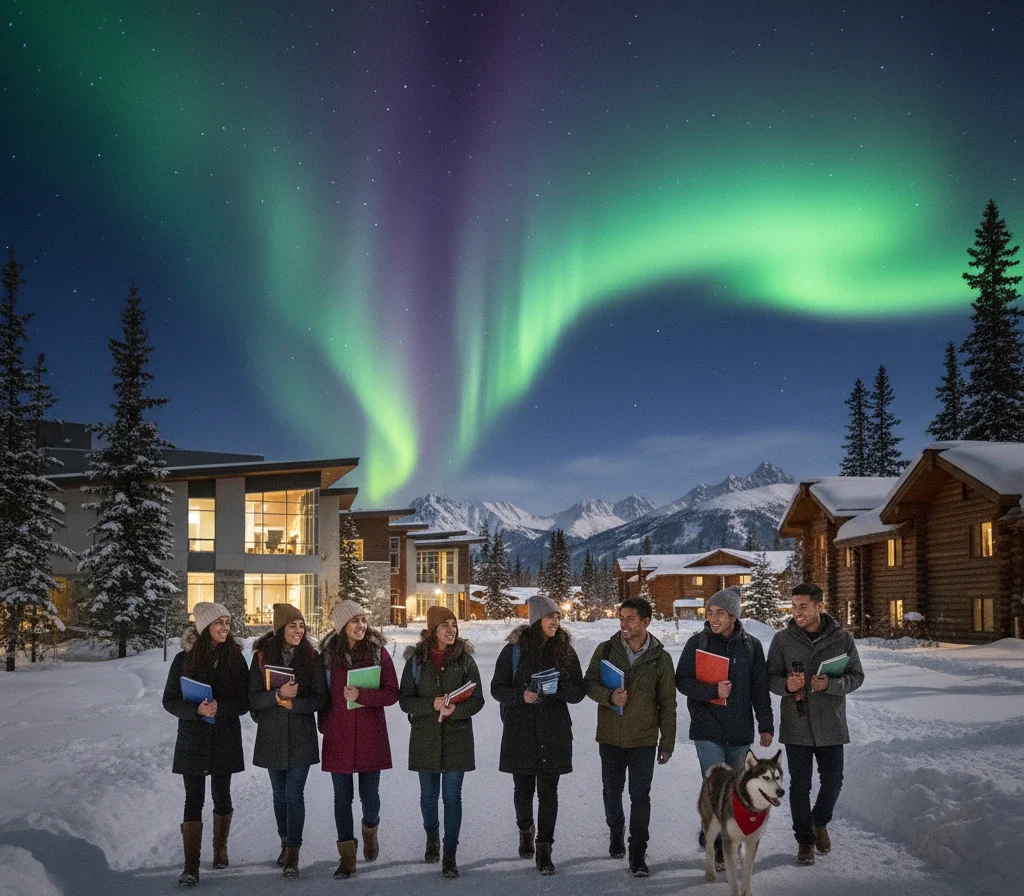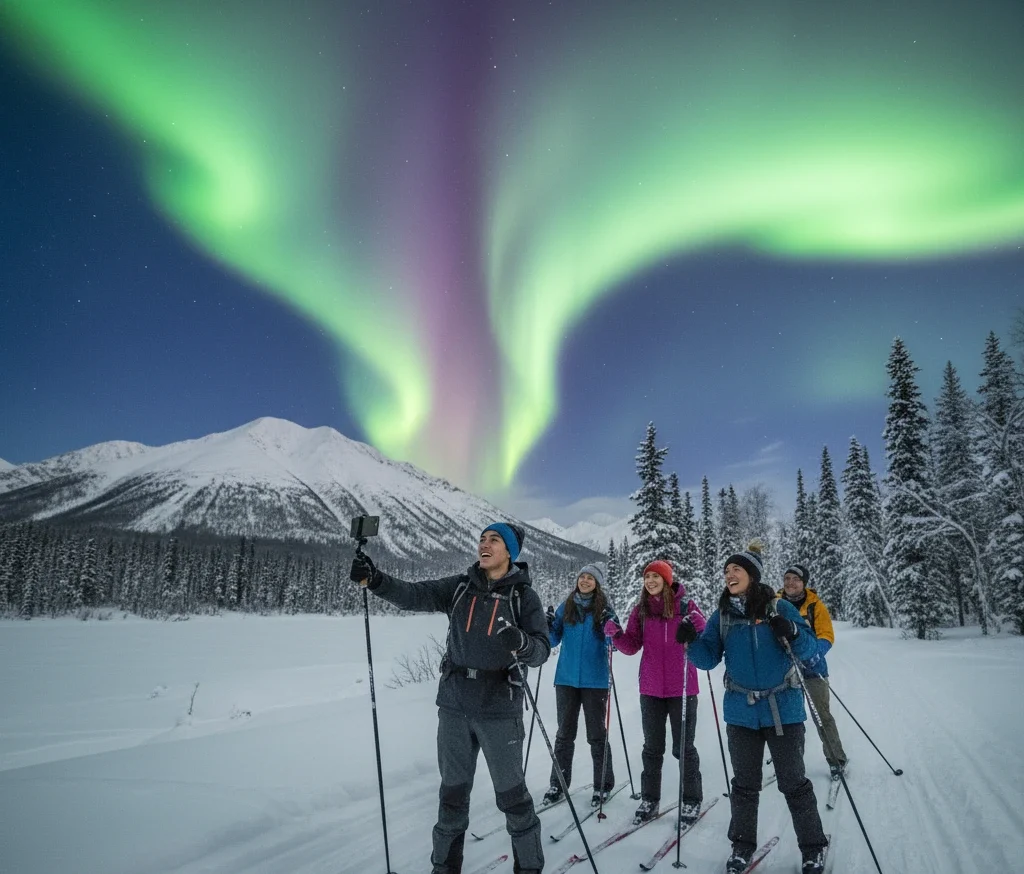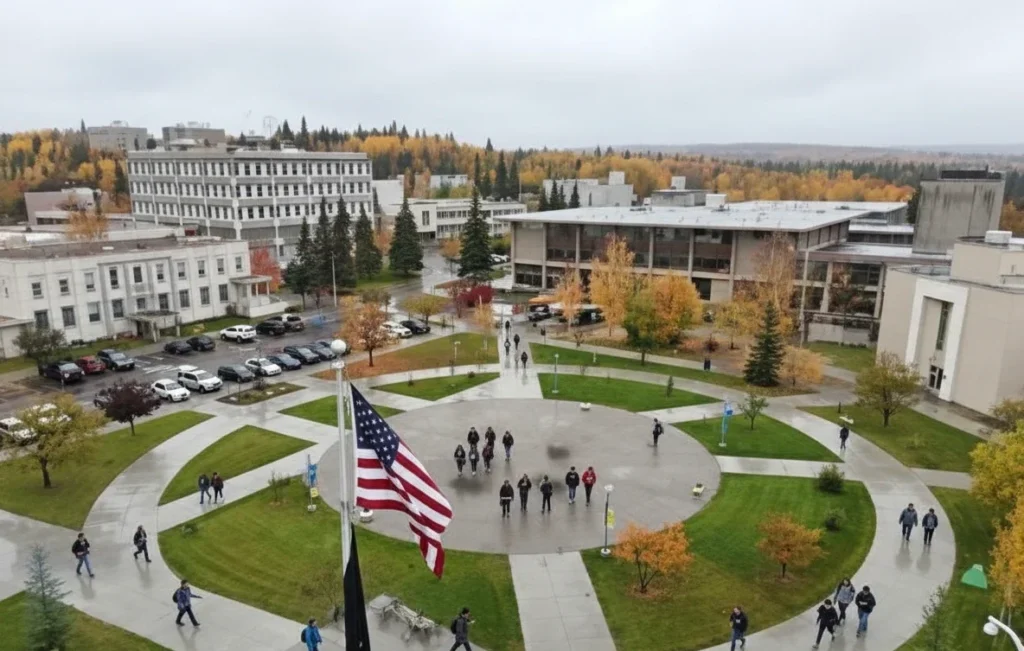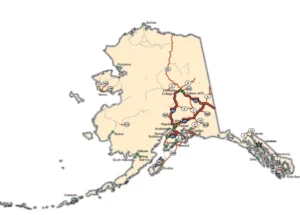If you’re considering where to continue your higher education in the United States, you might be surprised by what Alaska has to offer. Choosing to study in Alaska gives you access to respected public universities, affordable tuition, and cutting-edge Arctic research programs.
During the 2023–24 academic year, only 297 international students were enrolled statewide, according to this report from Alaska.edu, making Alaska one of the most exclusive and close-knit learning environments in the country.
With average annual education costs of around $50,000 and acceptance rates reaching 74% for international applicants at the University of Alaska Fairbanks, you’ll find both quality and accessibility in a place where education meets exploration.
Overview of International Education in Alaska

According to 2023-24 academic data, Alaska hosted 297 international students, representing approximately 2 percent of the state’s total university enrollment. While this figure ranks Alaska 52nd nationally, it shows consistent year-over-year growth of 2.4 percent.
The University of Alaska system (UAF, UAA, and UAS) enrolled 27,823 total students in 2024, contributing $10.1 million in economic impact from its international community.
| University | Total Students | International Students | Share of Total |
| University of Alaska Fairbanks (UAF) | 6,900 + | 148 | 2.1 % |
| University of Alaska Anchorage (UAA) | 15,000 + | 139 | 0.9 % |
| University of Alaska Southeast (UAS) | 2,000 + | 10 + | 0.5 % |
Countries of Origin for International Students
Most foreign students in Alaska come from nearby or Pacific-region countries.
| Rank | Country | Percentage of Total |
| 1 | Canada | 18.9 % |
| 2 | South Korea | 11.1 % |
| 3 | India | 8.1 % |
| 4 | Germany | 4.7 % |
| 5 | China | 4.0 % |
Canadian students form the largest group due to geographic proximity, while Asian representation mirrors national U.S. higher-education trends.
Leading Universities and Academic Focus

Here are some top universities in Alaska:
University of Alaska Fairbanks (UAF)
- Specializes in Arctic research, engineering, environmental science, and geophysics.
- Home to major centers such as the International Arctic Research Center and the Geophysical Institute.
- Offers undergraduate, master’s, and Ph.D. programs recognized globally.
University of Alaska Anchorage (UAA)
- Alaska’s largest university with programs in business, aviation, nursing, education, and health sciences.
- Provides applied research opportunities through partnerships with state and municipal agencies.
University of Alaska Southeast (UAS)
- Located in Juneau, known for marine biology, environmental studies, and liberal arts.
- Smaller class sizes and field-based learning opportunities.
Application Requirements for International Students
Undergraduate Admission
- Minimum GPA: 3.0/4.0
- Official secondary-school transcripts (WES evaluation recommended)
- Proof of English proficiency (IELTS, TOEFL, Duolingo, or PTE)
- Application fee: USD 50
- Late submission fee: USD 25
- Deadlines: May 1 (Fall) and September 1 (Spring)
Graduate Admission
- Accredited bachelor’s degree with a minimum GPA of 3.0
- Official transcripts, CV, and statement of purpose
- Three recommendation letters
- GRE / GMAT scores (if required)
- Application fee: USD 75
- Suggested submission: 6–9 months before the intended semester
More details and step-by-step guidance are available via EducationUSA.
English-Language Proficiency Requirements
| Test | Minimum Score |
| IELTS | 6.5 |
| TOEFL iBT | 79 |
| Duolingo English Test | 110 – 120 |
| PTE Academic | 55 – 58 |
Meeting or exceeding these scores is mandatory for full admission consideration.
Acceptance and Enrollment Statistics
- UAF acceptance rate (2024): 62 % overall; 74 % for international applicants.
- UAA: Open-admission policy; international acceptance is typically high.
- Enrollment trends indicate stable intake with modest year-over-year growth.
Tuition and Mandatory Fees (2025-2026)
| Institution / Level | Non-Resident Per-Credit (USD) | Approx. Annual Tuition & Fees |
| UAF Undergraduate | 898 | 29,190 (30 credits) |
| UAF Graduate | 1,155 | 22,140 (18 credits) |
| UAS Undergraduate Lower Div. | 841 | 25,000 (est.) |
| UAS Undergraduate Upper Div. | 890 | 26,000 (est.) |
| UAS Graduate | 1,128 | 20,000 (est.) |
Additional fees: Matriculation $225 (one-time), Student $56 / credit, Infrastructure $19 / credit, Textbooks $250–$1,100 per semester.
Housing and Accommodation

On-Campus Housing
| University | Room Type | Cost per Semester (USD) |
| UAF | Double + Meal Plan | 6,610 |
| UAA | Double Suite | 3,850 |
| UAA | Quad Suite | 3,550 – 3,875 |
| UAA | Single Suite | 4,250 |
| UAA | Apartment | 4,150 – 4,950 |
Off-Campus Rent (Average 2024-25)
| Location | 1-Bedroom Apartment | Median Home Value |
| Fairbanks | $ 1,099 / month | $ 286,960 |
| Anchorage | $ 1,344 / month | $ 387,882 |
Off-campus living offers independence but higher heating and transportation expenses during winter.
Estimated Monthly Living Expenses
| Category | Cost (USD per Month) |
| Food | 721 |
| Utilities (heat, water, electricity) | 178 |
| Internet | 115 |
| Transportation | 81 |
| Miscellaneous | 200 + |
| Total without Rent | ≈ 999 |
| Total with Rent | ≈ 2,440 |
Sample grocery prices: Milk $ 1.14/L, Bread $4.11, Eggs $4.80 (12-pack), Chicken $12.80/kg, Apples $7.63/kg.
Health-Insurance Obligations
| University | Provider / Requirement | Annual Cost (USD) |
| UAA | LewerMark Student Health Insurance (automatic for F-1 visa) | ~ 1,800 |
| UAS | Minimum $50,000 medical coverage, $7,500 repatriation, $10,000 evacuation | ~ 1,600 – 1,900 |
All international students must maintain valid medical coverage throughout their enrollment.
F-1 Student Visa Requirements and Process
| Item | Cost (USD) |
| DS-160 Application Fee | 185 |
| SEVIS I-901 Fee | 350 |
| Total Estimated Visa Cost | 535 |
Required Documents
- Valid passport (6 months beyond program end)
- Form I-20 from the university
- Proof of sufficient funds for tuition and living expenses
- English-language test results
- Financial and academic statements
Processing Steps
- Receive admission and Form I-20 from a SEVP-certified institution.
- Pay the SEVIS fee online.
- Complete DS-160 application at ceac.state.gov.
- Schedule a visa interview with the nearest U.S. Embassy or Consulate.
- Present documents and await approval.
For detailed policy updates, refer to U.S. Visas – Travel.State.Gov.
Financial Aid and Scholarships
| Scholarship / Program | Eligibility Highlights | Notes |
| UA Foundation Scholarships | Open to residents and international students; awards ≈ $ 5 million yearly | Apply Oct 1 – Feb 15 |
| Live and Learn in Alaska (UAA) | In-state tuition rates for students living on campus | Helps reduce overall tuition costs |
| Academic Honors Housing Scholarship | Merit-based discount ($ 750 per semester) | Available to UAA students |
| Fulbright Program | Graduate study funding for eligible countries | Competitive national program |
Students are encouraged to explore funding through their home governments and international organizations in addition to university aid.
Cost of Studying in Alaska (Annual Estimate)
| Expense Category | Undergraduate (UAF) USD | Graduate (UAF) USD |
| Tuition & Fees | 29,190 | 22,140 |
| Housing & Food | 13,220 | 20,900 (off-campus avg.) |
| Health Insurance | 1,800 | 1,800 |
| Books & Supplies | 2,000 | 2,000 |
| Personal Expenses | 2,250 | 2,250 |
| Transportation | 2,000 | 2,000 |
| Total Estimated Annual Cost | ≈ 50,460 | ≈ 51,090 |
These costs vary depending on housing selection, lifestyle, and travel frequency.
Academic Outcomes and Retention
| University | 6-Year Graduation Rate (All Students) | International Graduation Rate | Freshman Retention |
| UAF | 31 % | 57 % | 78 % |
| UAA | 27 % | 43 % | 68 % |
International students consistently demonstrate higher completion rates, reflecting strong institutional support and student engagement.
Climate and Living Conditions
Alaska’s sub-arctic climate requires preparation for extreme cold. Winter temperatures often fall below −20 °F (−29 °C), and daylight hours shorten significantly in December–January.
Average heating expenses: $150 – $300 per month.
Essential winter gear: thermal clothing, insulated boots, and snow tires ($800 – $1,200 if owning a vehicle).
Despite the climate, cities like Anchorage and Fairbanks maintain reliable infrastructure, public transport, and year-round social activities.
Employment and Post-Study Options
International students on F-1 visas may work:
- Up to 20 hours per week on campus during academic sessions.
- Full-time during official university breaks.
After graduation, students may apply for Optional Practical Training (OPT):
- 12 months for most fields.
- Up to 36 months for STEM-designated programs.
Alaska’s job market is strongest in engineering, energy, environmental sciences, tourism, and healthcare, offering potential placements under OPT or employer sponsorships.
Safety, Support, and Campus Services
- Alaska maintains one of the lowest crime rates among U.S. states in university regions.
- Campuses provide 24-hour security, health clinics, counseling centers, and student support offices.
- Each university has an International Student Services (ISS) department offering visa guidance, orientation programs, and peer mentorship.
Key Takeaways
- International enrollment in Alaska remains small but steadily growing.
- Tuition and living expenses are moderate compared to those in many U.S. states.
- Research in Arctic science and environmental fields offers unique academic value.
- Graduates show substantial completion and retention rates.
- Preparation for cold weather and budget planning are essential for incoming students.
Frequently Asked Questions
1. Is Alaska a suitable place for international students?
Yes. Although small in scale, Alaska offers a safe and academically focused environment with excellent research resources.
2. Can international students work while studying in Alaska?
Yes, F-1 students may work on-campus (up to 20 hours/week) and full-time during breaks.
3. How much does it cost to study in Alaska?
Total annual expenses range from $28,000 to $35,000, depending on program and living choices.
4. What are the English requirements to get admission in Alaska universities?
A minimum IELTS score of 6.5 or TOEFL score of 79 is required for admission.
5. Are scholarships available?
Yes, through the University of Alaska Foundation and other institutional grants.
Contact Information
- University of Alaska Fairbanks – uaf-admissions@alaska.edu | +1 907-474-7500
- University of Alaska Anchorage – uas.admissions@alaska.edu
- EducationUSA – educationusa.state.gov












